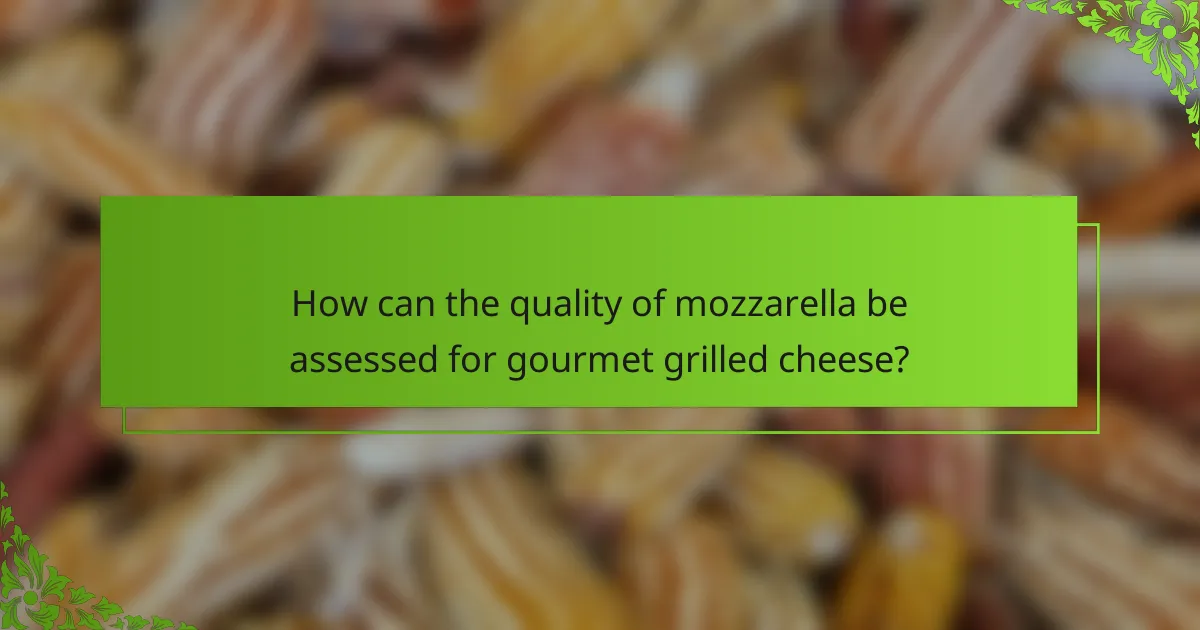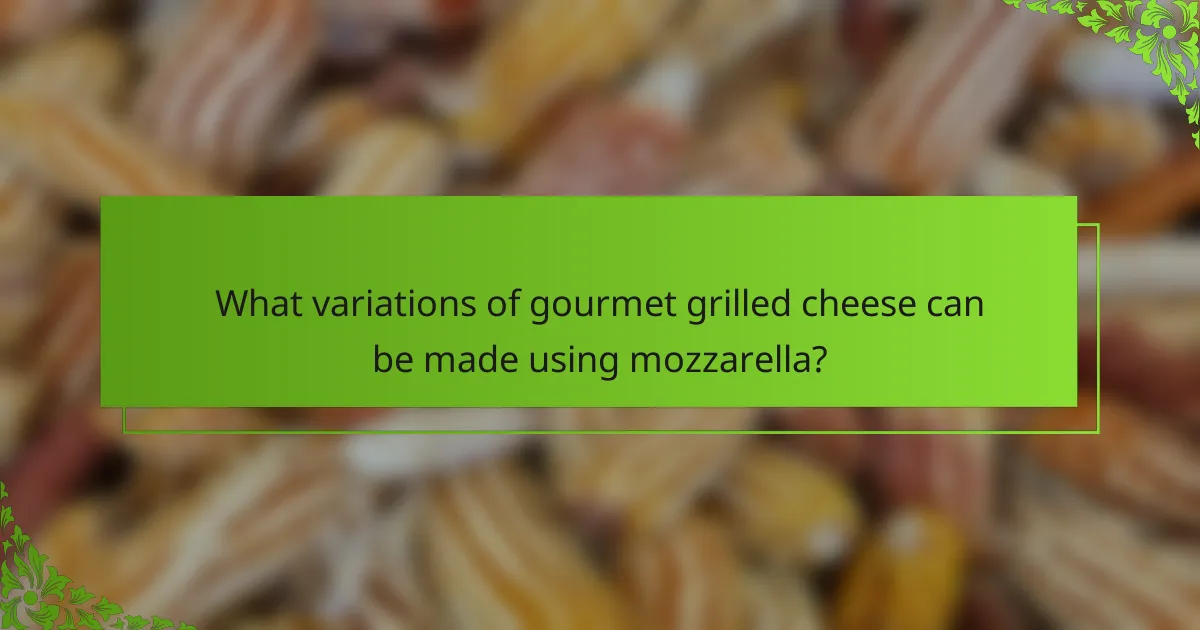Mozzarella is a soft, creamy cheese renowned for its melting properties, making it a key ingredient in gourmet grilled cheese sandwiches. This article explores how mozzarella enhances the texture and flavor profile of these sandwiches, focusing on its freshness, melting qualities, and rich taste. Key attributes for assessing mozzarella quality include freshness, texture, melting capabilities, and flavor, with sensory analysis serving as a method for evaluation. Various gourmet grilled cheese recipes that incorporate mozzarella, such as Caprese and pesto variations, are also highlighted, showcasing the cheese’s versatility and its role in creating satisfying meals.

What is Mozzarella in Gourmet Grilled Cheese?
Mozzarella in gourmet grilled cheese is a soft, creamy cheese known for its excellent melting properties. It enhances the sandwich’s texture and flavor profile. Mozzarella is made from water buffalo or cow’s milk. Its moisture content contributes to a gooey, stretchy consistency when melted. This cheese is often used in combination with other cheeses for added depth. The freshness of mozzarella elevates the overall taste experience. Many gourmet grilled cheese recipes highlight its use to create a rich, savory flavor. The combination of mozzarella with artisanal bread results in a delicious, satisfying meal.
How does the freshness of mozzarella impact gourmet grilled cheese?
Fresh mozzarella significantly enhances gourmet grilled cheese. Its freshness contributes to a creamier texture and richer flavor. Fresh mozzarella has higher moisture content, which aids in melting. This results in a gooey, indulgent consistency that elevates the sandwich experience. Moreover, the delicate taste of fresh mozzarella complements various gourmet ingredients. It balances stronger flavors without overpowering them. Studies indicate that fresher cheese retains more nutrients, enhancing overall health benefits. Thus, using fresh mozzarella is essential for achieving the best gourmet grilled cheese.
What attributes define fresh mozzarella?
Fresh mozzarella is characterized by its soft texture, mild flavor, and high moisture content. This cheese is made from water buffalo or cow’s milk. It is typically produced using the pasta filata method, which gives it its distinctive stretchiness. Fresh mozzarella is often sold in brine or whey to maintain its moisture. It has a creamy mouthfeel and a delicate taste that complements various dishes. The cheese is best consumed shortly after production for optimal freshness. Its melting qualities make it ideal for gourmet grilled cheese sandwiches. Fresh mozzarella is rich in protein and calcium, making it a nutritious option.
How can freshness be maintained when using mozzarella?
Freshness can be maintained when using mozzarella by storing it properly. Keep mozzarella in its original packaging until ready to use. If opened, submerge it in water or a brine solution to retain moisture. Refrigerate mozzarella at a temperature between 34°F and 40°F. Consume mozzarella within a week of opening for the best quality. Avoid exposing mozzarella to air, as this can lead to drying out. When preparing dishes, add mozzarella last to minimize its exposure to heat. These practices help preserve the texture and flavor of mozzarella, ensuring it remains fresh for culinary use.
What are the melting qualities of mozzarella in grilled cheese?
Mozzarella has excellent melting qualities in grilled cheese. It melts smoothly and evenly when heated. The cheese becomes stretchy and gooey, creating a desirable texture. Mozzarella’s moisture content contributes to its melting behavior. It typically contains around 50-60% moisture. This high moisture level aids in achieving a creamy consistency. Additionally, mozzarella has a mild flavor that complements other ingredients well. Its melting point is around 130°F to 150°F. This range allows it to melt without burning quickly. Overall, mozzarella enhances the grilled cheese experience with its melting properties.
How does mozzarella’s moisture content affect its melting properties?
Mozzarella’s moisture content significantly influences its melting properties. Higher moisture content typically leads to a creamier melt. This is because moisture facilitates the flow of fat and proteins during heating. In contrast, lower moisture mozzarella can become rubbery or chewy when melted. The ideal moisture level for optimal melting is around 45-60%. This range allows for a balance between stretch and softness. Studies show that high-moisture mozzarella produces a smoother texture and better flavor release when melted. Thus, moisture content is crucial for achieving the desired melting characteristics in mozzarella.
What types of mozzarella are best for melting in grilled cheese?
Fresh mozzarella and low-moisture mozzarella are the best types for melting in grilled cheese. Fresh mozzarella has a high moisture content, which provides a creamy texture when melted. It melts beautifully, creating a gooey, stretchy consistency. Low-moisture mozzarella, on the other hand, has less water content. This type melts evenly and develops a nice golden color when grilled. Both types offer distinct flavors that enhance the grilled cheese experience. Their melting qualities make them ideal for achieving the desired texture in this classic sandwich.
What flavor enhancements does mozzarella bring to gourmet grilled cheese?
Mozzarella enhances gourmet grilled cheese with a creamy, mild flavor. It adds a rich, buttery taste that complements other ingredients. The cheese’s fresh profile balances well with sharper cheeses. Mozzarella’s melting quality creates a smooth, cohesive texture. This texture enhances the overall mouthfeel of the sandwich. Additionally, its moisture content prevents dryness in grilled cheese. The cheese can also absorb and enhance the flavors of added herbs or spices. Overall, mozzarella contributes to a gourmet experience through its flavor and texture.
How does the flavor profile of mozzarella complement other ingredients?
The flavor profile of mozzarella is mild and creamy, which allows it to enhance other ingredients. Its subtle taste does not overpower but rather complements bold flavors like garlic, herbs, and spices. Mozzarella’s smooth texture also provides a pleasing mouthfeel alongside crunchy or crispy elements, such as toasted bread. The cheese’s moisture content helps to balance drier ingredients, creating a harmonious dish. Additionally, its ability to melt beautifully adds richness, enhancing the overall flavor experience. This versatility makes mozzarella a staple in gourmet grilled cheese sandwiches, pairing well with various meats, vegetables, and condiments.
What additional ingredients can enhance the flavor of mozzarella in grilled cheese?
Basil, tomatoes, and garlic can enhance the flavor of mozzarella in grilled cheese. Fresh basil adds a fragrant herbal note. Sliced tomatoes contribute acidity and juiciness. Minced garlic introduces a savory depth. Additionally, a drizzle of balsamic reduction can provide sweetness and tang. Each of these ingredients complements mozzarella’s creamy texture and mild flavor. They create a more complex and satisfying taste experience in grilled cheese sandwiches.

How can the quality of mozzarella be assessed for gourmet grilled cheese?
The quality of mozzarella for gourmet grilled cheese can be assessed through several key attributes. Freshness is a primary factor; high-quality mozzarella should be used within a few days of production. The texture is also important; it should be smooth and slightly elastic. Melting qualities are critical; good mozzarella should melt evenly and stretch without breaking. Flavor is another significant attribute; it should have a rich, creamy taste without being overly salty.
To evaluate these attributes, one can conduct a sensory analysis. This involves assessing the mozzarella’s appearance, aroma, texture, and taste. Additionally, checking for moisture content can indicate quality; ideal mozzarella should have a moisture content of around 50-60%.
Research shows that fresh mozzarella has superior melting properties compared to aged varieties. According to a study by the Dairy Research Institute, fresh mozzarella retains more moisture, resulting in a better melt. This combination of freshness, texture, melting qualities, and flavor ultimately defines the quality of mozzarella for gourmet grilled cheese.
What characteristics should be evaluated when selecting mozzarella?
When selecting mozzarella, evaluate its freshness, moisture content, and melting qualities. Freshness indicates the cheese’s age and flavor profile. Mozzarella should have a soft texture and a mild, milky taste. Moisture content affects its melting properties. High-moisture mozzarella melts smoothly and stretches well. Look for a cheese that is creamy and not overly dry. Melting qualities are crucial for dishes like grilled cheese. A good mozzarella should create a gooey, stringy texture when heated. These characteristics ensure an enjoyable culinary experience.
How do texture and taste contribute to the overall quality of mozzarella?
Texture and taste significantly enhance the overall quality of mozzarella. The texture is characterized by its smoothness and elasticity, which contribute to a pleasant mouthfeel. This unique texture allows mozzarella to stretch when melted, creating an appealing visual and sensory experience. The taste of mozzarella is mild and creamy, providing a subtle flavor that complements various dishes. High-quality mozzarella has a fresh, slightly tangy flavor, which indicates proper aging and production methods. Together, these attributes create a harmonious balance, making mozzarella a versatile ingredient in gourmet grilled cheese and other culinary applications.
What role does packaging play in determining mozzarella quality?
Packaging significantly influences mozzarella quality by protecting it from environmental factors. Proper packaging prevents moisture loss, which maintains the cheese’s texture and flavor. Additionally, it minimizes exposure to light, which can degrade the cheese. Vacuum-sealed packaging is particularly effective in preserving freshness. Studies show that mozzarella stored in airtight packaging retains its quality longer than those in non-sealed containers. This preservation is crucial for culinary applications, such as gourmet grilled cheese, where quality directly impacts taste.
What are the best practices for preparing gourmet grilled cheese with mozzarella?
Use high-quality, fresh mozzarella for the best gourmet grilled cheese. Fresh mozzarella has superior melting qualities, creating a creamy texture. Slice the mozzarella evenly to ensure consistent melting. Use a combination of cheeses for enhanced flavor, such as sharp cheddar or fontina. Choose artisanal bread, like sourdough or ciabatta, for added flavor and texture. Butter the outside of the bread for a golden, crispy crust. Cook on medium-low heat to allow the cheese to melt thoroughly without burning the bread. Flip the sandwich carefully to maintain its structure. Serve immediately for the best taste and texture.
How should mozzarella be sliced or shredded for optimal use?
Mozzarella should be sliced into thin, even pieces or shredded for optimal use. Thin slices allow for even melting and better integration into dishes. Shredding mozzarella increases its surface area, promoting faster melting and distribution in recipes. For best results, use a sharp knife or a grater for shredding. Fresh mozzarella is best sliced or shredded just before use to maintain its moisture and texture. Consistency in size ensures uniform cooking and enhances the overall eating experience.
What cooking techniques enhance the qualities of mozzarella in grilled cheese?
Using low and slow heat enhances the melting qualities of mozzarella in grilled cheese. This technique allows the cheese to melt evenly without burning. Cooking at a lower temperature ensures that the bread becomes golden brown while the mozzarella achieves a creamy texture. Additionally, using a lid while cooking traps heat and moisture. This creates a steam effect that further aids in melting the cheese. Buttering the bread enhances flavor and promotes browning. Using a cast-iron skillet distributes heat evenly, preventing hot spots. These techniques collectively improve the overall quality of mozzarella in grilled cheese.

What variations of gourmet grilled cheese can be made using mozzarella?
Caprese grilled cheese combines mozzarella with fresh basil and tomatoes. This variation highlights the freshness of ingredients. Pesto mozzarella grilled cheese includes pesto for a herby flavor boost. Spinach and mozzarella grilled cheese adds sautéed spinach for nutrition. Buffalo mozzarella grilled cheese features buffalo sauce for a spicy kick. Italian-style grilled cheese incorporates sun-dried tomatoes and olives. Each variation leverages mozzarella’s melting qualities and creamy texture. These combinations enhance the overall taste experience.
What are some popular gourmet grilled cheese recipes featuring mozzarella?
Classic Caprese Grilled Cheese combines fresh mozzarella, tomatoes, and basil on sourdough bread. The mozzarella melts beautifully, creating a creamy texture. Another popular option is the Pesto Mozzarella Grilled Cheese. This recipe features mozzarella with pesto sauce and sun-dried tomatoes. The combination enhances the flavor profile significantly. For a twist, try the Fig and Mozzarella Grilled Cheese. It includes mozzarella, fig jam, and arugula. This mix offers a sweet and savory taste. Each recipe showcases mozzarella’s melting qualities and fresh flavors.
How can different types of bread affect the overall dish?
Different types of bread can significantly affect the overall dish of gourmet grilled cheese. The choice of bread influences texture, flavor, and structural integrity. For example, sourdough offers a tangy flavor and chewy texture, enhancing the taste of mozzarella. Whole grain bread adds nuttiness and fiber, contributing to a heartier dish. Brioche provides a soft, buttery quality, making the sandwich rich and indulgent. Additionally, crusty bread can create a satisfying crunch when toasted, contrasting with the gooey cheese. The bread’s moisture content also impacts the melting qualities of mozzarella, affecting how the cheese stretches and binds the sandwich together. Thus, the selection of bread is crucial in defining the overall experience of the dish.
What unique flavor combinations can be created with mozzarella?
Mozzarella can be paired with various unique flavor combinations. One popular combination is mozzarella with fresh basil and ripe tomatoes, creating a classic Caprese flavor. Another intriguing mix is mozzarella with figs and prosciutto, offering a sweet and savory profile. Combining mozzarella with spicy jalapeños and creamy avocado adds a kick to the dish. For a fruity twist, mozzarella can be paired with peaches and balsamic glaze. Incorporating truffle oil with mozzarella elevates the flavor to gourmet levels. Additionally, mozzarella with roasted red peppers and olives creates a Mediterranean flair. These combinations highlight mozzarella’s versatility and ability to enhance different flavors.
What tips can enhance the experience of gourmet grilled cheese with mozzarella?
Use high-quality, fresh mozzarella for optimal melting and flavor. Fresh mozzarella has a higher moisture content, which enhances creaminess. Pair mozzarella with flavorful breads like sourdough or ciabatta. These breads provide a robust texture and taste contrast. Add complementary ingredients like fresh basil or tomatoes for added depth. Season the sandwich with a pinch of salt and pepper to elevate flavors. Grill the sandwich on medium heat for even melting without burning. Use a mix of butter and olive oil for a rich, golden crust. Serve immediately for the best texture and taste experience.
What are the common mistakes to avoid when making grilled cheese with mozzarella?
Using low-quality mozzarella can lead to poor melting. Fresh mozzarella has a higher moisture content, which can make the sandwich soggy. Not preheating the pan can result in uneven cooking. Cooking on too high heat can burn the bread before the cheese melts. Failing to use enough butter or oil can cause sticking and uneven browning. Overloading the sandwich with too much cheese can prevent proper melting. Skipping the lid on the pan can hinder heat retention, affecting the melting process.
How can presentation elevate the gourmet aspect of grilled cheese?
Presentation can significantly elevate the gourmet aspect of grilled cheese. A visually appealing presentation enhances the dish’s perceived value. Using artisanal bread and high-quality ingredients creates an upscale look. Arranging the sandwich with care can highlight its layers and textures. Incorporating colorful garnishes adds vibrancy to the plate. Serving with a side of gourmet dipping sauce can enrich the experience. Unique plating techniques, such as stacking or diagonal cuts, can create visual interest. These elements together contribute to an overall gourmet impression. A study by the Journal of Sensory Studies shows that visual appeal can influence taste perception.
Mozzarella is a key ingredient in gourmet grilled cheese, known for its soft, creamy texture and excellent melting properties. The article explores how the freshness of mozzarella enhances flavor and texture, the importance of moisture content for optimal melting, and the various types of mozzarella suitable for grilled cheese. Additionally, it discusses flavor combinations, best practices for preparation, and tips for assessing mozzarella quality. The content emphasizes how these factors contribute to creating a rich and satisfying gourmet grilled cheese experience.